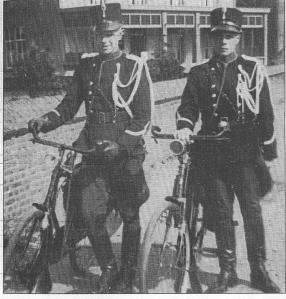Karst Smit was among the thousands of Allied soldiers at Dunkirk trying to get to England. He and 1500 Dutch soldiers were on the French merchant ship, Pavon, that was bombed and strafed by German fighter planes. After the badly damaged ship was beached and the wounded tended to, and with little hope of reaching England, Karst set off for The Netherlands.
He was not prepared to abandon the fight against the German occupier. But how to proceed? The answer was obvious: join the Royal Dutch Military Police, known as the Marechaussees. As a marechaussee he could carry a gun and be out after curfew. But, of course, the control of all police in the Netherlands was directly under the Nazis. Hitler appointed an Austrian, Dr. Arthur Seyss-Inquart, as High Commissioner for The Netherlands and, on the recommendation of Heinrich Himmler, he appointed another Austrian, Hanns Albin Rauter, as chief of police. In addition, Seyss-Inquart appointed Rauter as Commissioner-General of Security. As if that weren’t enough, Rauter was head of all SS troops in the Netherlands and received his orders directly from Himmler. (See Werner Warmbrunn’s The Dutch under German Occupation 1940-1945.) This made things rather difficult for an ordinary policeman, even a marechaussee, if he wanted to work against the Nazi regime.
The marechaussee uniform included such distinctive features as the tall hat (kepie), riding breeches (rijbroek), diagonal belt (schouderriem), decorative cords (nestels), and high boots (beenkappen), as shown in the picture above of Karst Smit and Albert Wisman. The Germans attempted to replace these uniforms with a German-style uniform but lack of material and sabotage by the marechaussees prevented it.
Marechaussees played key roles in the Smit-van der Heijden line. In addition to Karst Smit, there were the following, with the town where they were assigned after Karst arranged for a series of reassignments:
Aarts, Gijsbertus – Esbeek, Tilburg
Backx, Theo – Esbeek
De Bosch, Uit – Baarle-Nassau (?)
De Gier, Christiaan Gerardus – Baarle-Nassau
De Haan, Jan – Baarle-Nassau
De Pagter, Frederick (Freek )- Hilvarenbeek
De Wilde, Hendrikus – Tilburg (District commander of the Marechaussees)
Gerritsen, Geert – Baarle-Nassau
Gloerich, Anton – Baarle-Nassau (?)
Gommers, J.A. – Baarle-Nassau
Jonkers, David – Goirle
Keurhorst, Cornelis – Hilvarenbeek, then Strijbeek.
Lems, Ernst – Chaam
Lippens, Oscar – Baarle-Nassau
Meeuwisse, Huub – Goirle
Monnier, Wilhelmus (Wim) – Chaam
Mulderij, Kees – It seems likely that Mulderij of Moergestel was also in touch with Karst Smit. He played an active role in the help given to airmen.
Niessen, Hendrik – Baarle-Nassau. Previously from Waalwijk.
Poesiat, Hendrik Bart – Hilvarenbeek. Born in Amsterdam 25 Oct. 1917. Died at The Hague 22 April 1976. He guided escaped French prisoners of war in The Netherlands and helped several Dutch Jews, including the singer Re DeJong-Koster and her husband and Mr. C. Citroen and Mr. Vigeveno, whose escapes were described in the book Vlucht Over Vier Grenzen by John M.S. Lenck. The last address I have for him is 175, van Cranenburchlaaan, Wassenaar in 1973. His widow, Willy de Groot, stayed in Wassenaar until 1986 when she moved to the community of Scherpenzeel.
Selten, C.F.M. ( Kees) – Baarle-Nassau
Van Broekhoven, A.J. – Sgt. Major – Goirle
Van der Iest (Van Iest), Fokke – Goirle
Van Gestel, Adrianus (Adri) – Baarle-Nassau
Van Mastrigt, Jaap – Hilvarenbeek
Van Strien, Dingenis – Waalwijk (In an article by Eugene van der Heijden, among the escape line’s contacts, Van der Heijden listed “the police” of Waalwijk. Van Strien’s helper file at the U.S. National Archives credits him with helping four paratroopers.) Marechaussee Hendirk Niessen stated that he went from “Group Waalwyk” to Baarle-Nassau where he met Karst Smit. Niessen, therefore, provided a link to marechaussees and others in Waalwijk.
Verkaik, Leendert (“Leo”) – Karst Smit’s 1945 report identifies Verkaik as a gendarme in Riel, near Goirle and Tilburg. The helper file of Machiel Willem Rombout places Verkaik in Gilze-Rijen, halfway between Breda and Tilburg. Karst Smit said that after the Liberation Verkaik was serving with the Netherlands Forces Special Service (B.B.O.) in Utrecht.
Wisman, Albert – Esbeek and Hilvarenbeek
I will be adding more information about the above men later.

